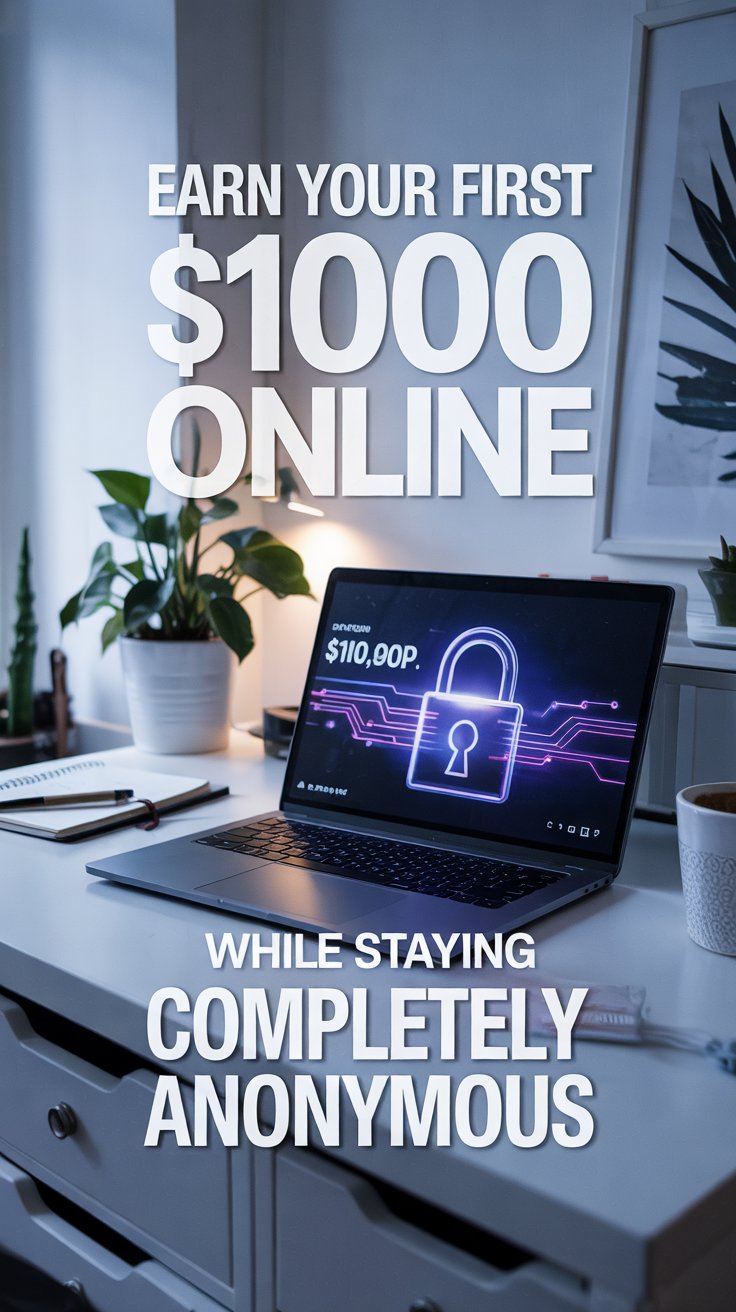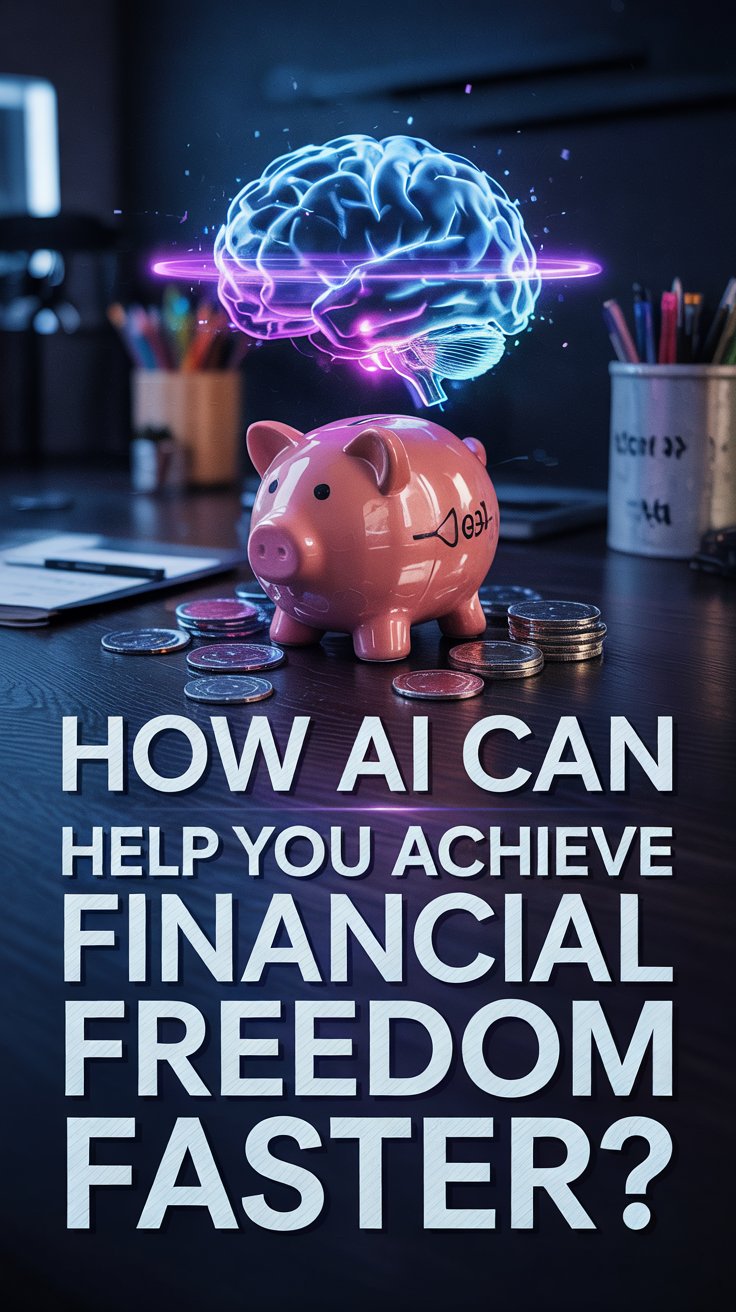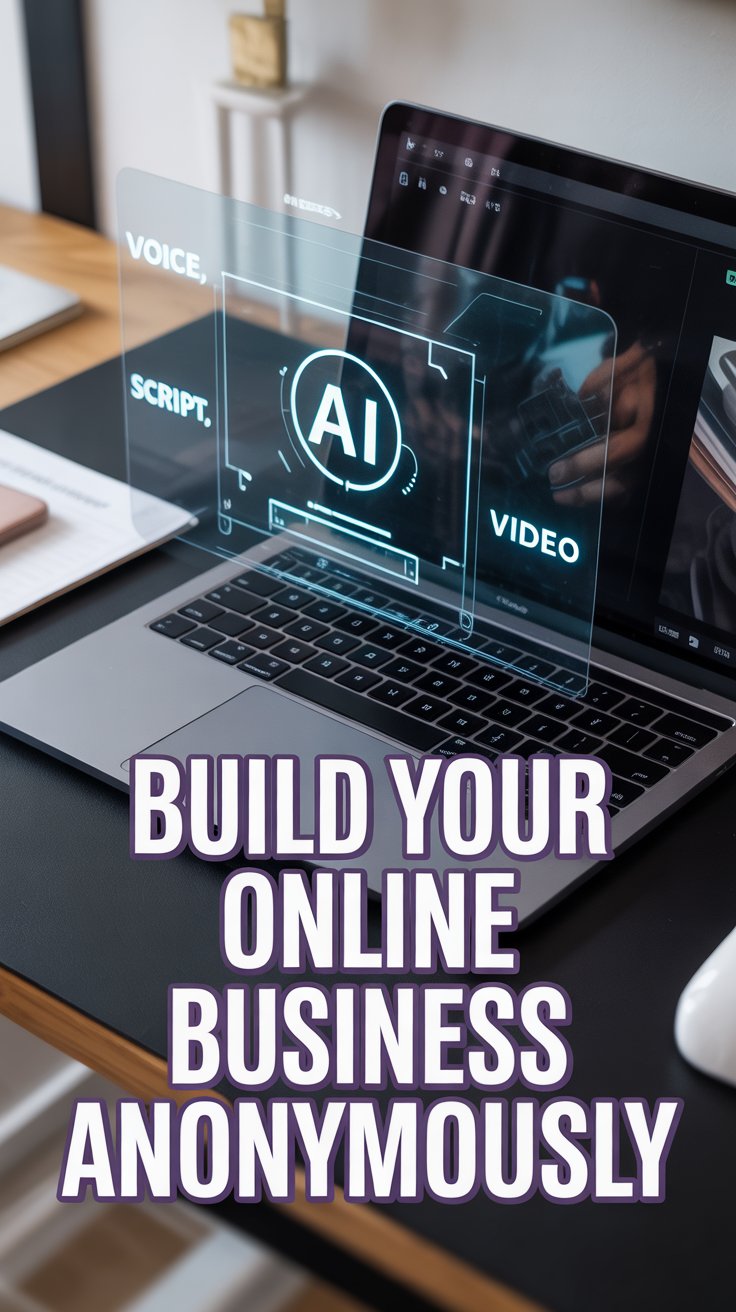Want to make your first $1,000 online without showing your face? I built a few anonymous income streams after a client asked for content “without the face, please.” I laughed, then I delivered, then I cashed the invoice. You can do the same and keep your privacy intact.
I work as a copywriter with 10 years in fashion, interior design, and gardening. I know what shoppers want, what brands pay for, and how creators stack small wins into real money. I use AI tools to move fast, stay consistent, and protect my identity when I need to. You want ideas that work, not hype. I got you.
I pulled together my favorite AI-powered side hustles that let you earn your first $1,000 online while you stay completely anonymous. I included steps, tools, and realistic ways to monetize. Ready to bank receipts without broadcasting your face to the internet? Let’s go.
1) Faceless Short-Form Videos with AI Voices (TikTok, Reels, Shorts)
I built a faceless interior-design tips channel and hit $1,000 in six weeks through affiliates and a simple ebook. I used AI voices, stock clips, and screen recordings. People cared about the info, not my face. Shocking, right?
You can create videos around style lookbooks, room makeovers, or garden hacks. You can share “before/after” edits, mood boards, and product roundups. You can keep your voice anonymous with AI TTS and never appear on camera.
- Tools I trust:
- CapCut or Descript for editing.
- ElevenLabs or PlayHT for AI voiceover.
- Pexels/Envato Elements for stock clips and music.
- Midjourney for room mockups, patterns, and “look” visuals.
- How you monetize:
- Affiliate links for decor, tools, or fashion staples.
- Digital guides (e.g., capsule wardrobe, plant care calendar).
- Brand UGC gigs that allow faceless content.
- How you stay anonymous:
- Use a pen name.
- Set up a brand email and LLC if you want extra privacy.
- Share screen recordings and AI-rendered rooms instead of your camera.
Bold takeaways: Post daily, batch scripts, and repurpose one video across three platforms. You create one workflow and triple your reach. You like efficiency, right?
A bright home studio with a clean white desk, dual monitors, a ring light, a mounted phone tripod, soft LED accent strips, fabric swatch books, a pinned vision board with interior sketches, and a few potted plants; wide-angle natural light from a big window; modern minimal decor in warm neutrals.
2) AI-Curated Niche Newsletter Under a Pen Name
I curate trend drops, decor sales, and seasonal gardening calendars under a pen name for a micro-newsletter. I keep it niche and useful. People open it because I save them time and money.
You can build a newsletter that tracks “new linen sofa releases,” “capsule wardrobe steals,” or “what to plant this month.” You feed it with AI summaries and your taste. Ever wonder why curation wins? People want filters, not firehoses.
- Tools I rely on:
- Beehiiv or Substack for hosting.
- Feedly + Perplexity for research.
- ChatGPT for concise summaries and subject-line ideas.
- Notion for an editorial calendar.
- How you monetize:
- Affiliate picks inside the email.
- Paid tiers for extra guides or templates.
- Sponsorships once you hit 1–2k engaged readers. I sold a $250 spot in month two.
- Anonymity tips:
- Use a brand logo and pen name.
- Collect payments via Stripe under your LLC.
You can hit $1,000 with a mix of affiliate commissions and your first sponsor. Focus on repeatable formats: “3 Finds / 1 Trend / 1 Deal.” Readers love rhythm.
A cozy reading nook with a Scandinavian writing desk, a slim laptop, a ceramic mug, a corkboard filled with clipped fashion lookbooks and paint swatches, a soft linen armchair, a floor lamp with warm light, and a window that frames leafy greenery; calm, minimal, inviting.
3) Print-on-Demand Patterns for Apparel and Home Decor
I spin up botanical and geometric patterns with AI and license them for pillows, tote bags, and wall art. People love fresh patterns, and you can keep your name off everything while your brand name takes credit.
You can create design packs around a theme: “Coastal Neutrals,” “Japandi Lines,” “Cottagecore Florals.” You upload patterns to POD platforms and let automated printing and shipping handle the rest. Why fight inventory when automation exists?
- Tools that work:
- Midjourney/Kittl for pattern design.
- Photoshop/Affinity for repeats and color tweaks.
- Printful, Printify, or Gelato for fulfillment.
- Etsy/Shopify for storefronts.
- How you monetize:
- Margin per item: $8–$18 on pillows, $5–$10 on tees.
- Bundle digital patterns for DIY makers on Creative Market.
- Upsell colorways and seasonal drops.
- Anonymity:
- Brand the shop with a studio name, not your own.
- Skip live customer chats and use templates for replies.
Focus on sets and cohesive collections. Collections push repeat purchases and mood board-friendly pins.
A textile design studio with a large table covered in printed fabric samples, a dress form draped in a patterned muslin, a wall of color swatch cards, a MacBook running design software, warm daylight from skylights, and a pegboard of tools; clean, creative, and tactile.
4) Etsy Digital Downloads for Designers, Stylists, and Gardeners
I sell interior mood board kits, planting trackers, and style cheat sheets on Etsy. I design the templates once and collect sales while I sleep. Yes, I smile every time that notification hits.
You can package Canva templates, color palette guides, garden planners, and wardrobe builders. You pick a niche, solve a common pain, and keep the file easy to customize. Ever noticed how people pay for shortcuts? They value speed.
- Build your offer:
- Validate with Etsy search and EverBee keyword data.
- Design in Canva or Illustrator.
- Add a mini guide that teaches quick wins.
- Monetize smart:
- Price at $9–$29.
- Offer bundles (save 20%) and seasonal updates.
- Drive traffic with Pinterest and Instagram carousels (faceless).
- Stay anonymous:
- Use a brand logo and generic product mockups.
- Keep your profile minimal and professional.
Highlight benefits in your listing: “Save 3 hours per room,” “Plan 12 weeks of blooms,” “Build 30 outfits from 12 pieces.” Clear wins sell.
A warm craft room with open shelving filled with labeled boxes, a tidy worktable with a laptop and tablet, framed art prints leaning on a ledge, a trailing pothos plant, and soft task lighting; inviting, organized, and creative.
5) Ghostwriting with AI for Boutique Brands
I write blog posts for small interior studios, indie fashion labels, and plant shops. I use AI to draft outlines, then I layer in research, interviews, and tone. I sign NDAs and deliver under their byline. They get content, I get paid, nobody posts selfies.
You can pitch niche expertise and move fast with AI assistance. Brands want consistent content that ranks and reads well. You provide that, you win repeat work.
- How you book clients:
- Build a faceless portfolio with samples under a pen name.
- Pitch on Upwork, Contra, or LinkedIn with a studio brand.
- Offer a trial post at your standard rate.
- How you deliver:
- Use ChatGPT for briefs and outlines.
- Polish with Grammarly and QuillBot for clarity.
- Optimize with SurferSEO or Frase.
- How you price:
- Charge $150–$400 per post (1,000–1,500 words).
- Sell packages: 4 posts = $600–$1,600.
- Add content calendars as a paid extra.
Keep your process clear, your deadlines tight, and your invoices friendly. You hit $1,000 with three to six posts for a single client.
A quiet home office with a walnut desk, an ergonomic chair, built-in bookshelves lined with design and gardening titles, soft window light, a notepad with handwritten briefs, and a plant on the sill; calm, focused, and professional.
6) Faceless Affiliate Roundups: Buyer Guides People Actually Use
I build buying guides that answer real questions: “Best linen sofa under $1,000,” “Most durable outdoor planters,” “Capsule wardrobe shoes that last.” I use AI for research, then I test claims or pull credible reviews. People want clarity when they spend.
You can run this with a dead-simple site or even a Notion page. You help readers decide fast and earn commissions when they click. FYI, you can drive early traffic with Pinterest or Reddit.
- Build and rank:
- Use LowFruits or Keywords Everywhere to spot low-competition terms.
- Draft in ChatGPT, then verify specs and add your take.
- Publish on Carrd, Notion + Super, or a lean WordPress.
- Monetize:
- Join Amazon Associates, LTK, or ShareASale.
- Add comparison tables and clear pros/cons.
- Include alternate picks for budgets and styles.
- Anonymity:
- Use a brand domain and generic author name.
- Keep socials faceless with renders and product shots.
You win when you pick intent-heavy topics and update guides monthly. Your first $1,000 often lands after a few solid guides that ride seasonal interest.
A modern living room workspace with a low sofa, a coffee table set up as a laptop station, product catalogs spread out, a pinboard of fabric and wood samples, tall plants by the window, and soft daylight; lived-in, stylish, research-ready.
7) Pinterest Automation for Stores and Creators
I helped a decor boutique grow from 30k to 1.2M monthly views with consistent, branded pins. Pinterest sends evergreen traffic when you feed it daily. You can manage this as a faceless service and charge a monthly retainer.
You can design pin templates, write descriptions with AI, and schedule a month of content in one sitting. Brands love the set-and-grow approach.
- Workflow:
- Research keywords with Pinterest Trends and Pin Inspector.
- Bulk design in Canva using templates.
- Write descriptions with ChatGPT and schedule in Tailwind.
- Offer tiered packages:
- Basic: 100 pins/month + analytics.
- Plus: 150 pins + 4 idea pins.
- Pro: 200 pins + strategy call.
- Pricing:
- Charge $300–$900/month depending on volume and niche.
- Upsell pin video edits and idea pin storyboards.
You hit $1,000 with two clients on mid-tier plans. You protect your identity with a studio brand and email-only communication.
A bright creative office with a long white table, mood boards on the wall, a large monitor displaying Pinterest analytics, bins of fabric and ribbon, trailing plants, and sunlit windows; airy, organized, and collaborative.
8) Sell AI-Generated Stock Photos, Mockups, and Room Sets
I create room mockups and flat-lay scenes that designers use for product previews. I shoot some scenes and generate others with AI. I license the sets on stock marketplaces and creative shops under a studio name.
You can produce styled interiors, garden backdrops, and fashion flat-lays. You can include negative space for text and consistent lighting. Ever wondered why some stock sells nonstop? Consistency and utility win.
- Production tips:
- Design scenes with Midjourney and refine in Photoshop.
- Build real flat-lays with softbox lighting and a foam board.
- Export multiple ratios and colorways.
- Where you sell:
- Adobe Stock, Shutterstock, Creative Market, Etsy.
- Bundle mockups with smart objects for drag-and-drop ease.
- Pricing and scale:
- Single packs at $9–$29.
- Big bundles at $39–$79.
- Hit $1,000 with a mix of bundles and a few high-performing listings.
Credit your studio and keep everything faceless. Use cohesive naming so buyers find your sets easily.
A daylight photo studio with seamless backdrops, a table for flat-lays, C-stands, softboxes, plants arranged as props, a camera on a tripod, and neatly labeled bins; spacious, bright, and production-ready.
9) Prompt Packs, Presets, and Color Palettes
I sell prompt packs for room renders, Lightroom presets for fashion shoots, and color palettes for different styles. Creators want shortcuts that look good out of the box. You deliver those shortcuts and keep your identity hidden.
You can build theme-based packs: “Wabi-Sabi Interiors,” “Urban Garden,” “Minimal Luxe Wardrobe.” You show before/after examples and offer refund-friendly clarity. You build trust fast with honest previews.
- What to create:
- Midjourney prompts for interiors and products.
- Lightroom presets for fashion and lifestyle.
- Palette packs with HEX and use cases.
- Where to sell:
- Gumroad, Lemon Squeezy, Ko-fi, or your Shopify.
- Promote on Pinterest and YouTube Shorts (faceless demos).
- Pricing:
- Packs at $12–$39.
- Bundles at $49–$79.
- Hit $1,000 with 25–60 sales, which you can reach with a few viral pins.
Focus on clear naming, clean previews, and one-click results. People pay for time saved and consistent aesthetics.
A color studio with a large work table, fanned paint decks, fabric books, two monitors showing before/after edits, a light meter, and soft neutral walls; balanced, artistic, and precise.
10) Micro-Products: Plant Care Chatbots, Room Palette Calculators, Capsule Wardrobe Generators
I build tiny tools that solve one job quickly. A plant care bot answers watering questions. A palette calculator suggests paint combos for north-facing rooms. A capsule wardrobe generator builds 30 outfits from 12 pieces. People love tools that remove friction.
You can assemble these micro-products without custom code. You can embed them on a simple site and charge a small fee. You can deliver fast updates because AI handles the heavy lifting.
- Stack to use:
- Tally or Typeform for inputs.
- Make/Zapier for workflows.
- ChatGPT API for logic and responses.
- Notion/Carrd for hosting.
- Monetization:
- Charge $5–$15 per access or $7–$19/month for unlimited use.
- Offer a lifetime plan during launch.
- Add email capture to upsell related templates.
- Anonymity:
- Run everything under a tool brand with a generic founder tag.
- Keep support in email or ticketing only.
Launch with one strong use case, then ship quick improvements. You hit $1,000 through a launch promo and a few micro-influencer shoutouts.
A sleek startup nook with a standing desk, an ultrawide monitor, a laptop on a riser, sticky notes with flowcharts, a whiteboard with arrows and boxes, and a snake plant by the window; clean, modern, and focused.
11) UGC Without Your Face: Hands, Flat-Lays, and Overhead Shots
Brands need user-generated content that highlights real usage. You can film hands-only tutorials, overhead unboxings, and styling demos. You never show your face, and you still charge per deliverable.
I shoot flat-lays for fashion clients and table demos for planters and soil mixes. I keep backgrounds neutral and the lighting soft. I edit fast with AI cut tools and deliver on schedule. You build a reputation for reliability, not selfies.
- How to pitch:
- DM brands with a faceless UGC reel.
- Offer packages: 3, 5, or 10 clips.
- Include usage rights and length in your offer.
- Production:
- Shoot on phone + tripod with top-down rig.
- Edit in CapCut, sharpen with Topaz Video.
- Write hooks with ChatGPT and add captions.
- Pricing:
- Charge $75–$300 per clip.
- Add cutdowns and alt hooks as upsells.
You hit $1,000 with one solid project and a few add-ons. Keep your location and identity private by using a studio alias and a PO box.
A tabletop content studio with a sturdy shooting table, an overhead rig arm, neutral backdrops, a tray of props, softbox lights, and shelves with organized product boxes; crisp, bright, and practical.
12) Brand Kits and Domain Flips with AI Naming and Logos
I build brand kits—names, logos, palettes—and list them on marketplaces that cater to startups. I register the best names, pair them with a clean logo, and sell the package for a markup. I never attach my real name to the listings.
You can generate names with AI, refine them, and build a small library of identities. You include a simple style guide and mockups to increase perceived value. Why fight for hourly gigs when you can sell complete packages?
- Workflow:
- Generate names with ChatGPT and Namelix.
- Design logos in Kittl or Figma; mock up in Mockuuups.
- Register domains via Namecheap.
- Where to sell:
- Squadhelp, BrandBucket, Etsy brand kits, your Shopify.
- Add social handle checks to sweeten the deal.
- Pricing:
- Kits at $199–$799 depending on quality and domain.
- Hit $1,000 with one strong sale or a few smaller ones.
Keep your studio brand front and center, and keep your identity off the listings. Buyers care about the asset, not the creator’s face.
A brand lab workspace with mood boards of logos and color chips, a long desk with two laptops, a lightbox showcasing business cards, shelves with neatly stacked brand books, and soft overhead lighting; creative, tidy, and professional.
How I’d Hit $1,000 Fast (and Stay Anonymous)
I stack one “fast cash” lane with one “compounding” lane. I pair faceless short-form videos (fast) with Etsy digital downloads or prompt packs (compounding). I post daily, push traffic to my store, and track results in a simple sheet. I keep my face off everything and let the work speak.
- Pick one content engine: shorts or Pinterest.
- Pick one product lane: templates, prints, or packs.
- Post daily for 30 days, then double down on your top sellers.
- Protect your info with a pen name, brand email, and LLC. IMO, that combo gives you maximum privacy with minimal fuss.
You want momentum, not perfection. You can learn on the job and refine as you earn. Keep the vibe friendly, keep the workflow simple, and keep your identity private. When your first $1,000 lands, take a screenshot for your private victory wall. You earned it 🙂
Final nudge: pick one idea, set a 30-day target, and ship something today. Ever notice how money follows the people who publish? That can include you—no selfies required.



